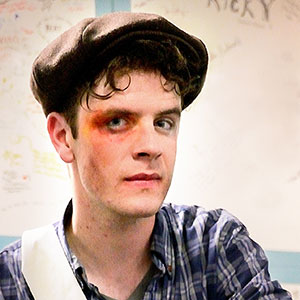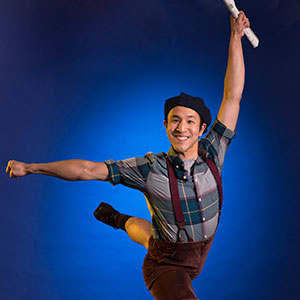

There are no windows in Kevin Hauge’s office. Instead, brightly colored theatrical posters hang from the walls. The titles are instantly recognizable: Billy Elliot, White Christmas, The Lion Kingeach bill illuminated by grinning casts who have come and gone. The room reads more like an exhibit of local theater history than a workplace.
“This kid on the end here,” Hauge says, pausing at a poster of West Side Story from 2007. “He’s one of the stars in Hamilton now.”
The young greaser in the photo is Ryan Vasquez, a CMT San Jose alum who recently passed through the Bay Area on a national tour of the hip-hop historical Broadway show that claimed almost every Tony Award in 2016.
“And there, that’s Carter Skeath,” Hauge says. “He’s [a] vice president of CBS.”
Each face has a name and a story. On his desk are black-and-white headshots of various actorssome teens, some in their 20sneatly arranged beside a near-toppling tower of miniature set designs. Standing in the midst of it all, Hauge assumes a look of pure contentment.
For 21 years, he has manned the creative vision of CMT San Jose, the oldest performing arts organization in the city. As the company embarks on its 50th anniversary season, Hauge maintains the same philosophy that started it alla fervent belief that the arts can, and will, transform the valley and its youth.
But there’s just one issue: People rarely appreciate what they don’t see.
Growing Pains
In many ways, CMT’s journey has trekked a double-edged sword. Its founder, John P. Healy, was 17 years old when he wrote and directed the company’s first production, Robin Hood. Featuring 35 neighborhood kids, including his own siblings, the play marked the beginning of a company built around youth. Healy envisioned a theater company where every child who auditioned would have a chance onstage.
This founding idea continues to be one of CMT’s core principles. But as the theater company has grown in size and stature, the unencumbered, anything-goes spirit of Healy’s youth-centric vision has given way to a more professional brandand the kids have ceded more and more control to the grown-ups.
Where kids used to do almost everythingfrom painting signs and sewing garments to writing and directing showsthe company now has board members, salaried staff and professional set and costume designers. In 1982, Healy left the company after a dozen years at the helm. Other founding members followed suit.
“I think that what happened is CMT lost its vision for a bit, and it really did get to be more about churning out stars versus the experience of the kids,” says Dee Dee Healy, John’s wife. “There are plenty of people who want to do it as professionally as possible and have more focus on the productions, but you lose something when you don’t allow the kids to do a lot of the work. That learning goes away.”
However, Dee Dee Healy notes that the company has come a long way under Hauge’s leadership.


“It’s at a much higher level now than it was in the days when John was involved,” she says. “That was important, and it was part of the growing pains that needed to happen for the theater.”
In recent years, the organization has been able to regain some of its original intention while still producing high-caliber shows worthy of national recognition.
Before opting for the acronym, CMT San Jose was known as the San Jose Children’s Musical Theater. On the main page of the company’s new website, “children” appears just once in the copyright line. The phrase “for all ages” takes center stage.
For almost the entirety of its life, the organization has grappled with the implications of its name. People are often quick to associate the term “children” with kiddie theater, succumbing to the knee-jerk reaction that a show featuring young actors couldn’t possibly be that greatamateur, even. It can be a challenge rallying theater patrons to come see a show.
“The downside is getting people into our theater,” Hauge says. “The upside is, I cannot tell you how many times in intermission or after a show, I have people I don’t even know who walk up to me and say, ‘I had no idea.'”
Hauge calls it a trade-off he gladly accepts.
“We have a responsibility, not only to our theater but theaters everywhere, to represent theater for youth as an art form unto itself,” he says.
As it stands, the “C” in CMT San Jose is here to stay. About five years ago, the company officially adopted the acronymic titlea middle ground in some respects. It allows them to get beyond the word “children” without diminishing the fact that young people are, and have always been, at the heart of the organization.
A common expression heard in the rehearsal hall: “We don’t do children’s theater, we do professional theater that happens to have children.” By setting high expectations for performers and producing quality shows, CMT believes it has solved the problem of the C-word.
Managing Director Dana Zell puts it this way: “Our strongest weapon is: ‘come see a show.'”
A Place for Everyone
When John Healy founded CMT in 1968, the company was known as the Cabrini Community Theater, named after its headquarters at the St. Francis Cabrini School’s bingo hall. Within a couple of years the company outgrew the space, so Healy moved operations to a now-abandoned, domed church on the north end of St. James Park, formerly known as the First Church of Christ, Scientist.
“He had this unbelievable energy. As a young person, I just remember it being really infectious,” says Michael Mulcahy, a former CMT executive director and current board member.
Under CMT’s tenure, the church was nicknamed the Palace of Performing Arts (P.O.P.A.) in honor of Mulcahy’s grandfather, widely known papi, who leased the space to Healy for a gracious sum of a dollar a month.
After leaving P.O.P.A., the organization struggled to find a permanent home, moving between various schools, churches and warehouse buildings before securing its current location on Parkmoor Avenue. Around that time, Hauge became CMT’s first-ever artistic director.
Under his leadership, the National Endowment of the Arts (NEA) has honored the theater 10 times for its cutting-edge productions and commitment to theater education. A half-century after its formation, the company has grown into a top-rated youth theater organization, drawing nearly 40,000 actors, volunteers and audience members a year.
Each summer, CMT unveils a lineup of 10 shows that include Broadway juggernauts and contemporary musicals, enlisting talents of all ages. The productions are broken into three distinct divisions: Rising Stars (ages 10-14); Mainstage (ages 14-20); and Marquee Productions, which feature a cast of CMT alumni and working actors from the Bay Area to New York and beyond. This milestone season kicked off earlier this month with a Rising Star production of Fiddler on the Roof Jr. Next up in December is the West Coast non-union premiere of Disney’s NEWSIES the Musical, performed by the Marquees.
Though much has changed since its shoestring days in a bingo hall, CMT has thrived by remaining true to its original vision. In the midst of arts organizations falling by the wayside in every city in America, the company continues to give every child the opportunity to experience the arts and realize their potential, whether it be in dance, song or any other avenue of theater.
This means casting everyone who auditions, regardless of financial or physical limitations. “I always think when people hear that, they’re going to be like, ‘Well, the shows can’t be very good,’ or they’re expecting dancing daisies or singing bunnies,” Hauge says. “But that certainly doesn’t define who we are.” Part of CMT’s mission is to show people that inclusivity and quality can, in fact, coexist. “It’s our job as artists to sculpt a show that uses everyone to the best of their abilities.”
As a result, CMT is home to hundreds of young performers each year, many of whom are experiencing theater for the first time in their lives. Those who started as toddlers have known each other for years. The same goes for their parents, most of whom are devoted volunteers of the organization and former CMT actors themselves.
“I’m a believer that organizations really don’t get the benefit of their years until they get to a place where it becomes multigenerational, and we’re at that place now,” says Mulcahy, who first encountered CMT when he was just 4 years old. He grew up watching his older sister perform with local kids until he was old enough to join them onstage. He went on to become the company’s executive director from 1993 to 2001, and in addition to his current role on the board, Mulcahy is an active Marquee performer. He’ll be playing the role of Joseph Pulitzer in Newsies. His three daughtersClaire, Ella and Camillehave also performed with the company.
The intergenerational nature of the organization is the key to CMT’s survival, Mulcahy says, and it will remain a crucial aspect for maintaining stability in the next half-century.
Every arts organization needs benefactors, though, and the city of San Jose remains a longtime CMT partner. For the 2017-2018 fiscal year, the city has allocated more than $192,000 to the company. In addition to annual grants, Mayor Sam Liccardo has already vowed to dedicate further funds to the company in support of its milestone season, according to Kerry Adams Hapner, director of the San Jose Office of Cultural Affairs.
While city officials have applauded the organization’s work, Mulcahy believes that artistic, youth-oriented spaces like CMT continue to be at risk.
“There’s a lot of energy around Google coming to San Jose and how we’re the high-tech capital of the world,” Mulcahy says. “But in the midst of all of that, we have a community that has lost arts organizations that were well-funded and well-celebrated by the city of San Jose.”
For Mulcahy, it’s a matter of readjusting community values and social priorities in favor of the arts, particularly organizations that serve to educate young people in ways that many public schools can’t afford to. As state funding continues to shrink and schools struggle to make ends meet, music and arts programs are often the first to go.
“When I was a kid, I’d have music class twice a week, and our schools all had musicals that were performed,” Hauge recalls. “It makes me sad to think of all these kids with this seed inside of them that no one is going to water.
“It’s important that all kids have an opportunity to know how the arts could change their life like it’s changed mine.”
By fostering a community of new artists and patrons, Hauge adds, the organization can help refocus the arts as a touchstone of San Jose culture.
“Wouldn’t we love to live in a town where the arts were valued greatly?” Hauge says. “I think a way to make sure that the future is still infused with the arts is exposing as many kids to it as early as possible, so that hopefully they and their families will see the value and will include it in their lives.”
Rise Up
Armando Gonzalvez first performed at CMT when he was 6 years old, starring in a Rugrats musicala fitting genesis for a kindergartner with big dreams. Three years later, in 2013, he landed his first lead role, in Heidi.
“I could distinguish my family’s cheers from the audience, and it was really great,” Armando says. “That’s probably the first moment that I realized I really like theater.”
Armando played the lead role of Tevye in Fiddler on the Roof Jr. Set in imperial Russia at the turn of the 20th century, the musical tells the story of a poor milkman who struggles to protect his family’s Jewish traditions in a rapidly changing world.
“I’ve grown up at CMT, and I’ve got a huge family now,” Armando says. “When you have something like this after school, when you get to enjoy yourself, it just makes being 13 a lot better.”
But for every prodigy the company might produce, dozens more kids will gain important life skills that can be applied onstage, at school or in the workplace.
“Our goal is not to create the next Broadway star,” says Zell, CMT’s managing director. A CMT alumna who performed as a high schooler in the mid-’80s, her two children, ages 9 and 12, are both Rising Star actors this season. Stardom is far from the first priority at this point, Zell says. “Our goal is to provide kids with a creative environment where they can have access to the performing arts and grow as an individual.”
Saying that, several kids have gone on to find success in the performance industry. Notable alumni include Alex Brightman, a Tony-nominated Broadway actor best known for his leading role in School of Rock; Nick Spangler, currently on tour for An American in Paris; and Ryan Vasquez, whose first CMT show was School House Rock at age 8.
“They cast everybody who auditions, luckily, or I never would have been cast and never would have done another show there again,” Vasquez told SHN Magazine, a Broadway San Francisco publication.
Were it not for CMT, it’s unlikely Vasquez would have embarked this year on Broadway’s national tour of the hit musical Hamilton. He and other alumni are just a few examples of what can be achieved when people are exposed to the arts at a young age.
“The kids are never going to fail you,” Mulcahy says. “If you surround them with professional, quality, artistic integrity, they’re going to rise to the occasion. You just have to give them the platform to be able to do that.”



